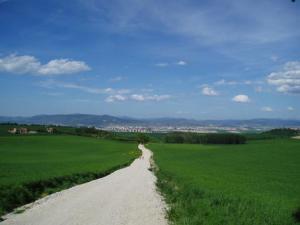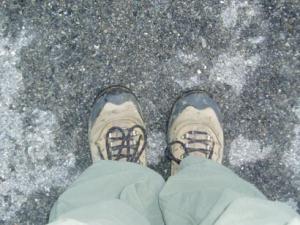
“If the camino doesn’t change your life, someone you meet on the camino will.”
For much of my life the Spanish word camino meant walk. That simple word turned out to be so much more. I found it would profoundly impact my life.
What initially began as a seed of curiosity, planted by the September 2004 issue of Frommer’s Budget Travel Magazine, billed as one of "Five Life-Changing Trips", had nurtured over time into a living entity, firmly rooted within my psyche.
When Uncle Sam’s check arrived in early January 2005, the Camino de Santiago de Compostela officially became my next adventure. Though I had been considering India as a potential destination, (another recommendation cited in the article), the final decision boiled down to climatic comfort. The mildly chilly Camino Frances in Spain won over the stifling heat of India during the month of May.

The Camino
Known to its travelers as simply the Camino, devout Catholics or the readership of Paulo Coelho’s novel The Pilgrimage and Shirley Maclaine’s autobiographical The Camino,
were just about the only people who knew it existed. Word spread in the last twenty years, especially in the 2004 Holy Year when a record number of pilgrims (an estimated 180,000) took the trails of Northern Spain by storm. Over the past twenty years, the number of pilgrims increased from 2,500 in 1986 to 94,000 in 2005. These numbers only represent an estimate based on pilgrims who chose to receive the compostela, or certificate of completion of at least the last 100 kilometers of the Camino by foot. Pilgrims may choose to complete a portion of their journey and return at a later date, or in some cases, not obtain a compostela for personal reasons.
Background
The Camino dates back to the 9th century, following the discovery of a silver ark in Galicia in the early 800’s (for lack of a more illustrated description, it looks much like the ark of the covenant from Raiders of the Lost Ark). The ark contained what was believed to be the ashes of St. James the Apostle. A magnificent cathedral was erected in the City of Santiago in honor of the discovery in 829.

Shortly after the construction of the cathedral began, Santiago became a focal point for Catholics, a place to pay homage to St. James, noted as a pilgrimage site in French monk Aymery Picaud’s guidebook in 113. Year round, pilgrims (travelers on the camino) travel from the South of France, Portugal and Northern Spain, following signed routes that millions of feet have walked upon since medieval times. The route from the South of France is called the Camino Frances, which is the route I hiked a portion of in May 2005.
Which Route
For most pilgrims, the trip begins in St. Jean-Pied-de-Port in Southern France. If you choose to begin in St. Jean, there are approximately 774 kilometers, 484 miles, left on your journey. You will find yourself walking in solidarity with people from all over the world, the most common age bracket between 19 and 60. In 2005, over 10,000 people were over the age of 60; and slightly less than 10,000 were between the ages of 13 and 18. The route takes you through France and either over the Pyrenees using the "Napolean Route", (not advisable in inclement weather which can occur any time of year), or following major roads using the aptly named "Road Route". From here, it is approximately 42 miles to Pamplona, where I began.

Starting Point
The starting point varies from person to person, based on time and ability. I chose Pamplona so that I could spend a week exploring Barcelona, Bilbao and San Sebastian prior to starting the camino. A series of planes, trains and buses brought me to Pamplona. After questioning several roaming college students on lunch break, I found the route, waymarked with the familiar yellow scallop shell.
A rudimentary knowledge of Spanish is recommended while you consider abandoning the added weight of an English-Spanish dictionary.
As you travel on the Camino, you will eventually whittle down your belongings to what is absolutely necessary to keep you alive and well. You’ll be surprised at the end result. A recommended pack weight according to the bible for the Camino, The Confraternity of St. James Pilgrim’s Guide to Spain: The Camino Frances, is 10% of your body weight. A pack weight of thirteen pounds for me would have been a miracle; I was closer to twenty (embarrassingly started out in Pamplona with much more). Depending on your seasons, the pack weight will change – winter, heavier; summer, lighter. Fortunately, the postal service has evolved over time to graciously accommodate those who pack without thinking, like myself. Pilgrims can mail articles they wish to keep posta restante to Santiago, picking them up after arriving at the final destination.
A typical day was spent smelling crisp, clean air under a canopy of bright, blue skies and a handful of clouds, watching a distant city decrease proportionately in size relative to the day’s progress and silence.

Very seldom did I see other hikers. For most of the journey, it was me and the road ahead. I was blessed to be able to sing aloud, pontificate quietly, listen for an occasional bird in the distance, or to the sounds of my footsteps crunching in the dirt below.
By the end of the journey, I had picked up a few scars, more miles than my Montrail boots could count, a friend for life, an affair to remember and the possibility of a new vocation. Indeed, it was a life-changing experience because I am finally finishing this article almost two years later in Trieste, Italy, where – after eight years of environmental consulting – I quit my job and decided to become a writer.
What the future may hold is uncertain, but I will always have the confidence that it is just me and the road ahead.